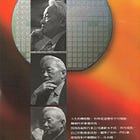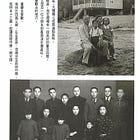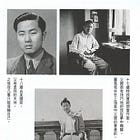Ch 3: A hot-blooded decision over $1 (1/3)
An English Translation of Morris Chang's Autobiography Vol 1 Ch 3 (Part 1) originally published in 1998
Note: This is an unofficial, non-commercial translation of Morris Chang’s memoir, shared for educational and entertainment purposes only. Full disclaimer below.
Morris Chang once had the first volume of his autobiography translated to English. But he remarked in a 2007 conversation at Stanford with Jensen Huang and Dr. John Hennessy that he was dissatisfied with it, and therefore chose not to publish it.

Chapter 3: Entering the semiconductor industry in 1955
Now where do I find a job?
Just like the naive assumption that led me to study mechanical engineering “machines are used everywhere,” so I discovered that merely because machines are ubiquitous does not mean companies would clamor for a mechanical engineering master’s degree holder.
A mechanical engineering diploma did not necessarily promise better job prospects than any other engineering discipline. At that time, America’s burgeoning aviation industry and massive automobile manufacturers hired legions of mechanical engineers; even the declining steel and machine-tool industries, still employed substantial numbers of mechanical engineers.
A master’s degree from MIT was, nonetheless, in high demand. If a mid-size or large American company needed a steady influx of engineering graduates, it would almost invariably send recruiters to MIT every year, especially during February and March when companies sought to hire students graduating in the summer. As I was ready to start work immediately, my candidacy was all the more appealing. I underwent countless preliminary interviews at school, receiving five or six invitations for on-site interviews. After those plant visits, I waited at home for responses. Within two months of my doctoral failure, I had received four job offers.
Four offers in hand
Among these four, one came from a well-known machine-tool manufacturer. During the interview, a Vice President—an accomplished scholar whose works I had long admired—spoke with me. We had a stimulating conversation, leaving me full of hope. A formal offer eventually arrived, but alas, the monthly salary was far too low (I recall it being around $380). Compared with other offers, it was uncompetitive, so I had no choice but to give it up.
Another offer came from a mid-sized company called Metals and Controls, Inc.1 The supervisor who interviewed me was the company President himself. He had immigrated from Europe years before, and still spoke English with a trace of a Central European accent. He was highly knowledgeable, witty, but also gave the impression of being an autocrat. Thus, I harbored some reservations about working there. His offer eventually came, offering $420 a month—still significantly less than what the other two companies proposed. I had no desire to accept it. By a curious twist of fate, Metals and Controls, Inc. was acquired by Texas Instruments a few years later.
The third offer was from the illustrious Ford Motor Company. By revenue scale, Ford likely ranked among the world’s top ten companies at the time, employing hundreds of thousands of people. Headquartered in Detroit, it had plants and subsidiaries worldwide. The unit interviewing me was its central R&D division in Detroit. My interviewer was merely on the manager level but nonetheless oversaw dozens of engineers. Ford offered me $479 a month.
The fourth offer came from a company whose name I knew, but they were recruiting me for a new business unit which was just being established–and in a field utterly unfamiliar to me. This company was Sylvania, famous for light bulbs, televisions, radios, and vacuum tubes. Now they were venturing into a new domain—semiconductor-based “transistors.” While I had heard of “semiconductors” in my mechanical engineering courses, I knew nothing beyond the name. As for “transistors,” I had never even heard the term.
How, then, did I happen to seek employment at Sylvania? Purely due to an offhand remark by my third uncle. During the period of confusion and dejection following my doctoral failure, I visited my uncle’s home one day. He said, “A Chinese friend visited me recently. He just joined Sylvania, working on transistors, and he mentioned there are several Chinese engineers there. Why don't you give it a try?” I phoned Sylvania, and a few days later went for an interview.
The interviewer was the director of the semiconductor laboratory, a slightly stout, authoritative American middle-aged man who seemed well-versed in semiconductors (I would learn later that people truly knowledgeable in semiconductors were far and few between, and this lab director was not among them). He told me his mission was to transform the “laboratory” into a large factory. In that process, they would need to automate production. Since I had a mechanical engineering master’s and had studied “automatic control,” I might be helpful with automation. This conversation neither sparked much interest nor aroused much hope. Yet, unexpectedly, a job offer arrived, at $480 a month—one dollar more than Ford’s offer.
Negotiating backfired
Now I faced a choice between Ford and Sylvania. By any rational measure, Ford seemed the obvious pick. The most important reason was that with my mechanical engineering background, I felt confident at Ford. The vague talk of “automation” at Sylvania, on a technology I barely grasped, offered no such reassurance. Also, during my interview, Ford’s R&D environment appeared orderly, and I had a good rapport with my prospective supervisor. Sylvania, on the other hand, left an impression of chaos; the lab director seemed indifferent. Furthermore, Ford, a giant corporation, carried an undeniable allure at that time. Concerns about bureaucracy at big firms or the ease of advancement in smaller firms were viewpoints that only emerged in subsequent decades. In the 1950s, most people sought employment at large companies.
Of course, Ford had a drawback: the job was in Detroit, a two hours’ flight from New York (there were only propeller planes then). My parents, though middle-aged and healthy, were not enthusiastic about having their only son so far away, but they did not strongly object to it either.
After a few days deliberation with my parents, my uncle, and my wife, I had nearly decided on Ford. I was only slightly dissatisfied by the one-dollar salary difference. I believed I could negotiate a higher salary from Ford. Bolstered by a momentary surge of courage, I phoned Ford, intending to “bargain.”
My first attempt was a collect call, made with some confidence. After I gave the secretary my name, she checked and returned with, “I’m sorry, Ford does not accept collect calls.” Undeterred, I decided to call back at my own expense (or more accurately, at my parents’ expense, as I was calling from their home). This time, after connecting, I spoke respectfully: I said I very much wanted to join Ford, but another company offered a higher salary. Would Ford consider raising my starting pay? The manager, the same person who had interviewed me, now sounded cold and curt, a far cry from his previously congenial manner: “We do not haggle. The company has decided on your salary. If you want to join, come. If not, then farewell.”
I tried to be clever, and clearly it backfired. If it were me today, I'd probably just chuckle, let it roll off my back, own it quietly, and still go to Ford. But young and hot-headed, I became angry out of embarrassment. That anger led me to reverse my thinking. I had felt confident about Ford’s job, but was I truly unwilling to take a risk at Sylvania, to do work I didn’t fully grasp?
I had considered my rapport with the Ford supervisor excellent, yet his coldness in that brief conversation shattered my trust.
Ford’s large scale supposedly guaranteed stability, but maybe the fast development in semiconductors would provide me greater growth opportunities. I stewed for a few days and with that humiliation still fresh, I arrived at a conclusion I would have deemed impossible before: I would go to Sylvania!
Life’s turning points arise so unpredictably! A short phone call, compounded by a young man’s impulsive pride, sealed my lifelong bond with semiconductors.
There is an “epilogue” regarding Ford. Twenty years later, I was a Group Vice President at Texas Instruments (TI), in charge of worldwide semiconductor operations. One of Ford’s senior executives had retired and joined TI’s board. As per TI’s tradition, each new board member underwent a training period, touring major TI facilities accompanied by a senior leader. I accompanied him for several days. One evening, after a good meal and wine, I recounted my Ford story. Visibly moved, he placed both hands on my shoulders, saying: “Morris, you’re truly fortunate. Had you joined Ford back then, you’d probably still be stuck in Ford’s R&D department, languishing.”
Entering the semiconductor industry!
In May 1955, Boston was basking in the gentle warmth of mid-spring, and I started at Sylvania’s semiconductor laboratory.
As the name implies, a semiconductor’s conductivity lies between that of a conductor (like metals) and an insulator (like wood or stone). Another crucial property is that by adding certain “impurities,” one can alter the material’s conductivity. Scientists had long known semiconductors existed but did not know how to use them. It was not until 1948 when scientists at Bell Labs exploited these properties to create the transistor, and everything changed.
The transistor’s applications were immediate and evident. Compared to the then-important vacuum tubes, which were critical electronic components, transistors were far smaller, lighter, and consumed less energy. They were poised to displace vacuum tubes rapidly.
Moreover, because transistors were small, light, compact, and energy-efficient, transistors could enable entirely new functionalities that vacuum tubes could not support—transistors became the primary components in computers, missiles, satellites, and more. In short, once invented, the transistor’s practical importance was universally acknowledged in the scientific community. Within a few short years, the academic term “semiconductor” metamorphosed into the name of an entire industry.
Why do we call it the “semiconductor industry” rather than the “transistor industry?” In the 1950s, the semiconductor business was indeed almost synonymous with transistors. While some did call it the “transistor industry,” most stuck to the “semiconductor industry.” Why? It was due to technological optimism! Most in the field believed transistors were not the sole semiconductor invention—surely more would come. They were proven right: semiconductor lamps, semiconductor lasers followed suit, and more importantly, the integrated circuit (IC) was invented in 1958. Today, ICs account for 85% of the semiconductor industry.
Nowadays, many call Taiwan’s semiconductor industry the “IC industry.” They are not wrong, indeed most semiconductor products today are ICs. Yet I, too, remain an incurable optimist about technology. I firmly believe semiconductors harbor infinite mysteries, and ICs are merely their current incarnation. One day—perhaps years, perhaps decades hence—another semiconductor-based invention may arise. Thus, I prefer the broader term: “semiconductor industry.”
Returning to my new employer, Sylvania and the transistor’s 1948 invention. This invention was no less consequential than that of the electric light, telephone, or steam power. The three inventors—Bardeen, Brattain, and Shockley—jointly received the 1956 Nobel Prize in Physics. Bell Labs, fully aware of the transistor’s importance, began licensing manufacturers to produce transistors in 1952. By 1953, commercial transistors appeared. When I joined Sylvania in 1955, around twenty or thirty companies were already in the semiconductor business, roughly falling into two categories.
The first category comprised large electronics companies or those closely tied to electronics. At that time, the largest electronics industries were radios and televisions, but the computer industry was on the horizon. This group included General Electric, Radio Corporation of America (RCA), IBM, Motorola, Sylvania, Sperry Corporation, and others. The second category was small, obscure companies hoping to capitalize on this “technological turning point.” There were quite a few in this category, and Texas Instruments (TI) was the most successful example.
Aside from these two categories, there was also AT&T, the parent of Bell Labs. However, AT&T’s interest in transistors was limited to use cases in their telephone systems.
Thus, when I joined the semiconductor industry despite being only a few years old, it was already in a “Warring States” period. Of course, I only began to understand these industry dynamics months after joining Sylvania. When I started, I was just an inexperienced apprentice.
Discussion questions:
What have been the most unexpected outcomes in negotiations you’ve conducted?
What were the early days in your industry like? Would you describe it as a “Warring States” period? How did it stabilize?
Were there moments you regretted not negotiating? What happened? What would a different outcome have been?
For continuity and context, readers are encouraged to refer to the previous installments of this series:
Disclaimer:
This is an unofficial translation of the memoir of Morris Chang. It is a non-commercial, unaffiliated work intended solely for educational and entertainment purposes.
All rights to the original text and its contents are fully retained by the original author and copyright holders. This translation has not been authorized, approved, or endorsed by Morris Chang, his representatives, or any affiliated publishers.
This content should not be relied upon for scholarly or commercial use, and no part of this translation may be reproduced, redistributed, or sold. If you are the copyright holder and have any concerns, please contact me directly.








